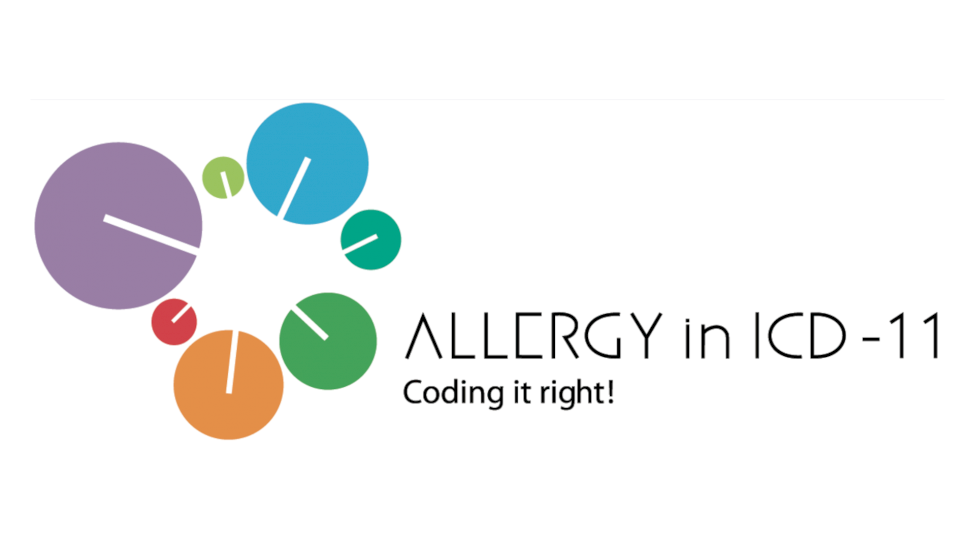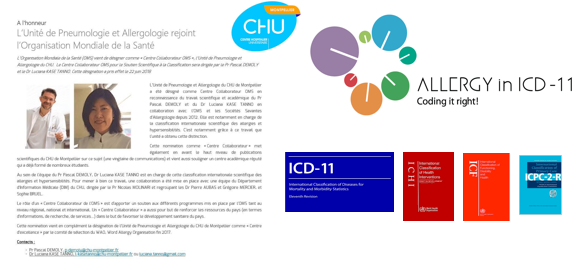Allergic and hypersensitivity conditions (A/H) are one of the fastest growing conditions worldwide, becoming a major public health problem. A/H are now the fourth most chronic disease in the world. WHO predicts that in 2050, 1 in 2 people in the world will suffer from allergies with a steady increase in A/H, especially in industrialized countries. Most of cases of A/H are first seen by general practitioners (GPs), pediatricians or emergency doctors. However, until now, A/H disorders have been under-represented in the World Health Organisation, International Classification of Diseases. (WHO ICD.)
The ICD is a global standard diagnostic classification for mortality and morbidity statistics maintained by the WHO. The under-representation of A/H disorders in the ICD impacts negatively in health information, which is used for statistics and epidemiology, health care management, allocation of resources, monitoring and evaluation of research, prevention and treatment. As an example, an analysis using the Brazilian Mortality Information System demonstrated under-notification of anaphylaxis deaths due to the difficulties of coding them using the ICD-10 (Tanno et al, Allergy 2012). In turn, missing epidemiological information leads to uncertainty about risk factors impacting negatively on care. For example, better quality information leads to better targeting strategies to protect patients at risk, and supports decision-making to facilitate healthcare planning and implementation of public health measures to prevent these conditions. Globally a negative outcome of anaphylaxis under-notification is the lack of adrenaline auto-injectors in more than 65% of countries.
Triggered by the 2012 publication and considering the ICD-11 revision as a key window of opportunity, a detailed academic and evidence-based action plan took place under the ALLERGY in ICD-11 initiative, lead by Luciana Kase Tanno (LKT) and Pascal Demoly (PD), with the aim of creating a more appropriate classification for A/H conditions in this new edition of ICD. This work consisted in strategic international actions acknowledged by the Joint Allergy Academies* and the ICD representatives at the WHO. These efforts have been documented in peer-reviewed publications** and resulted in the construction of the new “Allergic and hypersensitivity conditions” section under the “Disorders of the Immune system” chapter.
We were also able to push changes in the WHO mortality coding rules by including A/H as possible underlying cause of death in official death certificates, which will contribute for having more accurate mortality data in the years to come.
The ICD-11 framework is completely digital and additionally enables diagnoses to be linked to a range of parameters by the addition of one or more “extensions”, classified under the “Extension codes” X chapter in a process termed post-coordination. WHO has been promoting this classification strategy in which a stem entity (e.g., Anaphylaxis) can be more fully defined by linking it to a range of different value sets including severity, anatomical location and causal agent. The ICD-11 also allows the alignment with other classifications such as the International Classification in Primary Care (ICPC)-3, recent released by WONCA International Classification Committee (WICC). In 2019, LKT has been invited to the WICC meeting to present the work in ICD-11, since becoming a full WICC member.
In recognition to the work done and with the aim of formalizing the collaboration with WHO-Family on International Classifications (FIC), the WHO Collaborating Center (WHO CC) for the Scientific Classification of Allergic and Hypersensitivity Diseases was established in June 2018 at the University Hospital of Montpellier, and the integration among the 20 members of the Medical and Scientific Advisory Board to support the WHO ICD and other international classifications.
As the only WHO CC addressed to A/H conditions, we intend to establish close collaboration with national and international bodies in order to implement actions for better patients care, monitoring and prevention, developments in research and launch measures in order to reduce avoidable deaths. In this context, we have been working to promote quality care of allergic patients through producing international guidelines, such as the World Allergy Organization 2020 Guidance, and supporting awareness through the World Allergy Week which topic will be anaphylaxis prevention (https://www.worldallergy.org/resources/world-allergy/2021).
Our WHO CC has also contributed to the implementation of the codes related to the COVID-19 pandemic in order to monitor morbidity, mortality statistics and vaccination. Besides all the efforts addressed to the implementation of the ICD-11 and other WHO international classifications, our WHO CC works in collaboration with a multitude of groups of health care professionals, including GPs, in order to strengthen the health care pathways and improve the quality of care of patients.
The ICD-11 has been presented and fully endorsed during the last World Health Assembly (May 2019) and the implementation of this new classification is ongoing worldwide. The full implementation is expected by 2022. The construction of the new classification of A/H disorders in ICD-11 can be considered to be a timely and much needed milestone in the history of the allergy specialty and the wider world given the epidemiological importance of primary care data. More reliable, accurate, comprehensive and comparable A/H epidemiological data will provide a much better global picture of these conditions and will support improvements to the management of allergic disorders worldwide.
Luciana Kase Tanno, MD PhD
Pascal Demoly, MD PhD
ALLERGY in ICD-11 initiative leaders
Heads of the Montpellier WHO Collaborating Centre on Classification Scientific Support
* Joint Allergy Academies: American Academy of Allergy Asthma and Immunology (AAAAI), European Academy of Allergy and Clinical Immunology (EAACI), World Allergy Organization (WAO), American College of Allergy Asthma and Immunology (ACAAI), Asia Pacific Association of Allergy, Asthma and Clinical Immunology (APAAACI), Latin American Society of Allergy, Asthma and Immunology (SLAAI)
** ALLERGY in ICD-11 references:
https://o nlinelibrary.wiley.com/doi/pdf/10.1111/j.1398-9995.2012.02829.x
https://www.ncbi.nlm.nih.gov/pmc/articles/PMC4405839/
https://onlinelibrary.wiley.com/doi/full/10.1111/all.12386
https://onlinelibrary.wiley.com/doi/full/10.1111/all.12604
https://www.ncbi.nlm.nih.gov/pmc/articles/PMC4482039/
https://apallergy.org/DOIx.php?id=10.5415/apallergy.2015.5.4.193
https://onlinelibrary.wiley.com/doi/abs/10.1111/all.12834
https://www.sciencedirect.com/science/article/abs/pii/S2213219816000210?via%3Dihub
https://www.sciencedirect.com/science/article/abs/pii/S2213219816000507?via%3Dihub
https://e-aair.org/DOIx.php?id=10.4168/aair.2016.8.4.383
https://onlinelibrary.wiley.com/doi/abs/10.1111/all.12945
https://apallergy.org/DOIx.php?id=10.5415/apallergy.2016.6.3.149
https://onlinelibrary.wiley.com/doi/abs/10.1111/all.13006
https://www.sciencedirect.com/science/article/abs/pii/S2213219816302719?via%3Dihub
https://www.ncbi.nlm.nih.gov/pmc/articles/PMC4977713/
https://onlinelibrary.wiley.com/doi/abs/10.1111/all.13093
https://www.annallergy.org/article/S1081-1206(16)31273-X/fulltext
https://www.ncbi.nlm.nih.gov/pmc/articles/PMC5237226/
https://www.ncbi.nlm.nih.gov/pmc/articles/PMC5301440/
https://www.ncbi.nlm.nih.gov/pmc/articles/PMC5356259/
https://www.ingentaconnect.com/content/ocean/aap/2017/00000038/00000004%3bjsessionid=fn3kgo1o8nb68.x-ic-live-02
https://onlinelibrary.wiley.com/doi/full/10.1111/all.13335
https://www.tandfonline.com/doi/full/10.1080/1744666X.2018.1520094
https://insights.ovid.com/pubmed?pmid=30730395
https://www.jacionline.org/article/S0091-6749(19)30664-5/pdf
https://www.ncbi.nlm.nih.gov/pmc/articles/PMC7211746/
https://onlinelibrary.wiley.com/doi/10.1111/all.14468


